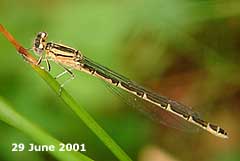Go to the last entry of the month...............Go to previous entry
I must catch up with some tadpole images in the next couple of days. I have had some problem getting the light correct for them!
The pond skaters (Gerris lacustris) are regulars on the surface of the ponds. Although I have not yet taken a picture of an adult so far this year, here is a very young pond skater nymph resting on duckweed. its body is about 2mm long.
A young newt is developing its front legs, the left one seen here below the external gills. There are a lot of newt 'tadpoles' in the pond now.
3 June - No pond dipping today, but another of our larger pond plants is coming into flower, the Branched Bur-reed (Sparganium erectum). It has an interesting flowering arrangement - the sphere with the white bits around it is the female part, and the smaller spheres are the male parts of the 'flower'. I will take some close-ups tomorrow.
4 June - First, a close-up of the female part of the flowering head of the Bur-reed. The white parts ready to catch airbourne pollen. It is ready to do this before the male parts on the same flower head release their pollen.
Some time over the weekend the snails in the tank have laid two groups of eggs on the glass. Here is a close-up of the larger group. The outer covering over the eggs measures about 5mm across. I estimate that each egg measures about 0.6mm across. The tiny spot seen in each one is the snail embryo. It looks as though one of the eggs is infertile.
The lower 'umbrellas' are the male structures (Antheridiophores). These produce sperm that then relies on rain to help them reach the female structures, the taller structures (Archegoniophores) which contain eggs. When the eggs are fertilised they will develop into spore sacs on the underside of each umbrella. I shall have to watch for these. The 'umbrellas' grow out of the broad,flat, leafy thalli ( one is called a thallus) that grow almost flat against the surface of the log and the stone below it. At the same time as the Liverwort reproduces sexually, the surface of a thallus may also have these structures. They are Gemmae cups. The round clumps of plant cells in them are called gemmae. When it rains, water droplets will splash into the cups and carry the gemmae off to grow into new plants if they find a suitable place.
8 June - A look at the snail eggs this morning reveals developing embryos, although they are nowhere near resembling a snail yet.
11 June - A quick bit of pond dipping showed
the frog tadpoles still looking like tadpoles with no signs of
legs yet. There was at least one young newt in every scoop. Some
looked as though they had not long emerged from an egg, However,
this one is the first one I have found that has developing hind
legs.
While I was doing a bit of
pond management a dragonfly arrived and perched on the log. I
think it was a Four-spotted Chaser, but I was not able to take
a photograph.
13 June - The first of the Willow Herb flowers opened this morning. This one is the Hoary Willowherb (Epilobium parviflorum). The flowers are less than 1cm across. The Great Willowherbs have not even got visible flower buds yet. The toad made its first appearance of the month.
15 June - In the small pond the rush plant is in flower now, really showing up well when the sun shines on it. I think that it is a Soft Rush (Juncus effusus). Frog activity seems to be going through a quiet spell at the moment with most of them staying hidden.
Most of the the snail's eggs are well developed now. In the close-up the orange coloured area is the developing shell.
Sharing the tank with the snails are a couple of flatworms. The picture shows the underside of one. I think it belongs to the genus Dugesia. These are fascinating to watch as they move about, twisting like ribbons as they change direction during their hunt for food.
In the pond, the Water Forget-me-nots (Myosotis scorpioides) are flowering profusely (left). There has been a surprise development at the shallow end of the pond. Among the Irises and the Bur-reed a Common Reedmace is making itself known by throwing up a flowering stem which is now well over 6ft tall. The surprise is based on the fact that I did not plant a reedmace. I shall include a picture of its flowering spike as soon as it is produced, which will be soon.
Occasionally, when I clear small amounts of weed around the sides of the pond I come across one of the less often seen inhabitants of the pond. I found this bi-valve yesterday. It is about 8mm across and the two shell valves are equal in shape, suggesting that it is a Sphaerium species (Freshwater Cockles, Orb Mussels). While they can grow to 25mm across the young can be found moving about on plants. ............................................................
At last I have had the first chance this year to capture an image of a damsel fly as it settled on a rush to rest for the night. I need to look more closely before identifying it. |
|
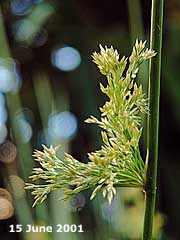
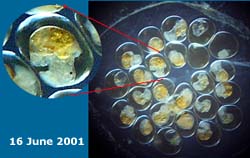
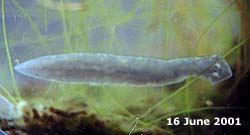
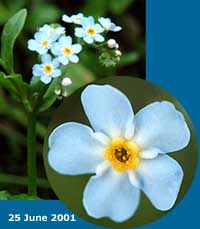 26
June - For the last
week or so I have been rather distracted from taking too much
time following progress in the pond. I am afraid that in that
time the snail eggs have 'hatched' and the snails dispersed amongst
the plants.
26
June - For the last
week or so I have been rather distracted from taking too much
time following progress in the pond. I am afraid that in that
time the snail eggs have 'hatched' and the snails dispersed amongst
the plants.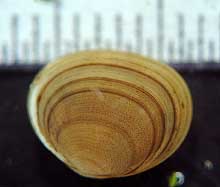
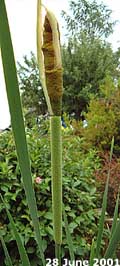 28
June - Here is the
reedmace flower spike. The male and female flowers are in two
groups. The lower, light green section is occupied by the immature
female flowers. The top, orangy brown section is made up of the
male flowers which will mature first to release their wind borne
pollen. The female flowers should mature in time to catch some
of this pollen.
28
June - Here is the
reedmace flower spike. The male and female flowers are in two
groups. The lower, light green section is occupied by the immature
female flowers. The top, orangy brown section is made up of the
male flowers which will mature first to release their wind borne
pollen. The female flowers should mature in time to catch some
of this pollen.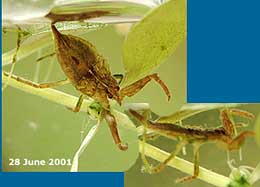 A
young Pond Scorpion (Nepa cinerea) turned up in a bit
of weed taken out of the pond this morning. Its body measures
about 7mm long, including the breathing tube at its rear. When
it reaches adulthood the tube alone can measure over 10mm. It
has a flattened body that makes it look like a dead leaf, and
it clings to the vegetation waiting to grab its prey with its
front legs.
A
young Pond Scorpion (Nepa cinerea) turned up in a bit
of weed taken out of the pond this morning. Its body measures
about 7mm long, including the breathing tube at its rear. When
it reaches adulthood the tube alone can measure over 10mm. It
has a flattened body that makes it look like a dead leaf, and
it clings to the vegetation waiting to grab its prey with its
front legs.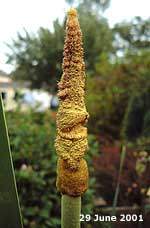 29
June - One day later
and the shrouds have been blown away from around the male inflorescence
of the reedmace. Its yellowish flowers could be seen releasing
pollen in the wind gusts today.
29
June - One day later
and the shrouds have been blown away from around the male inflorescence
of the reedmace. Its yellowish flowers could be seen releasing
pollen in the wind gusts today.